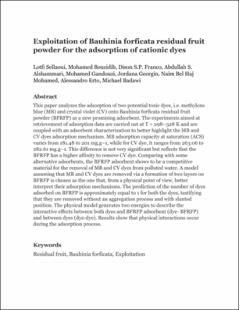Exploitation of Bauhinia forficata residual fruit powder for the adsorption of cationic dyes
Artículo de revista
2023
Elsevier
Chemical Engineering Journal
456
This paper analyzes the adsorption of two potential toxic dyes, i.e. methylene blue (MB) and crystal violet (CV) onto Bauhinia forficata residual fruit powder (BFRFP) as a new promising adsorbent. The experiments aimed at retrievement of adsorption data are carried out at T = 298–328 K and are coupled with an adsorbent characterization to better highlight the MB and CV dyes adsorption mechanism. MB adsorption capacity at saturation (ACS) varies from 181.48 to 201 mg.g−1, while for CV dye, it ranges from 263.06 to 282.61 mg.g−1. This difference is not very significant but reflects that the BFRFP has a higher affinity to remove CV dye. Comparing with some alternative adsorbents, the BFRFP adsorbent shows to be a competitive material for the removal of MB and CV dyes from polluted water. A model assuming that MB and CV dyes are removed via a formation of two layers on BFRFP is chosen as the one that, from a physical point of view, better interpret their adsorption mechanisms. The prediction of the number of dyes adsorbed on BFRFP is approximately equal to 1 for both the dyes, testifying that they are removed without an aggregation process and with slanted position. The physical model generates two energies to describe the interactive effects between both dyes and BFRFP adsorbent (dye- BFRFP) and between dyes (dye-dye). Results show that physical interactions occur during the adsorption process.
- Artículos científicos [3154]
Descripción:
Artículo
Título: Exploitation of Bauhinia forficata residual fruit powder for the adsorption of cationic dyes.pdf
Tamaño: 57.36Kb
 PDF
PDF
 LEER EN FLIP
LEER EN FLIP
Título: Exploitation of Bauhinia forficata residual fruit powder for the adsorption of cationic dyes.pdf
Tamaño: 57.36Kb
 PDF
PDF
 LEER EN FLIP
LEER EN FLIP









